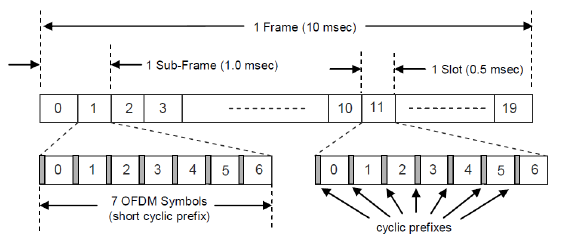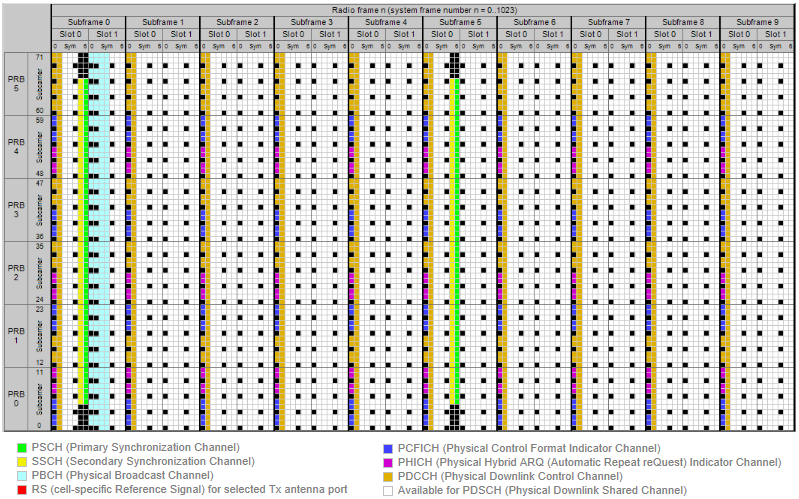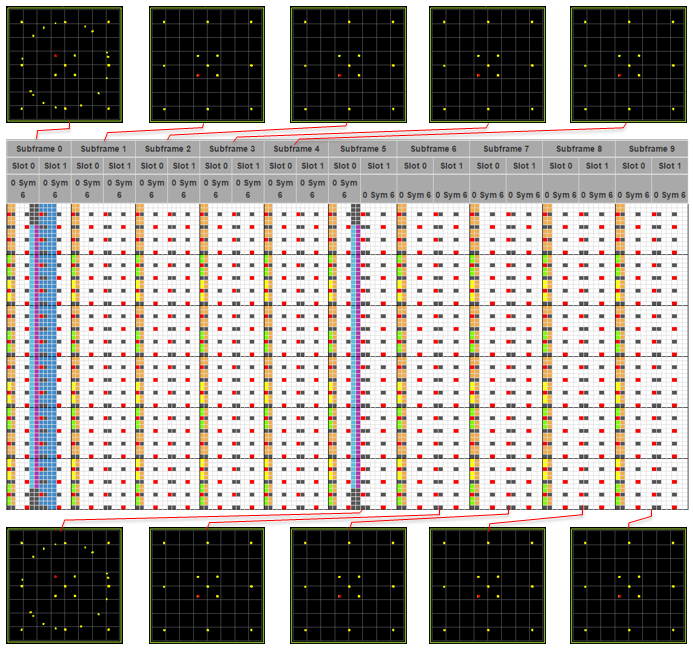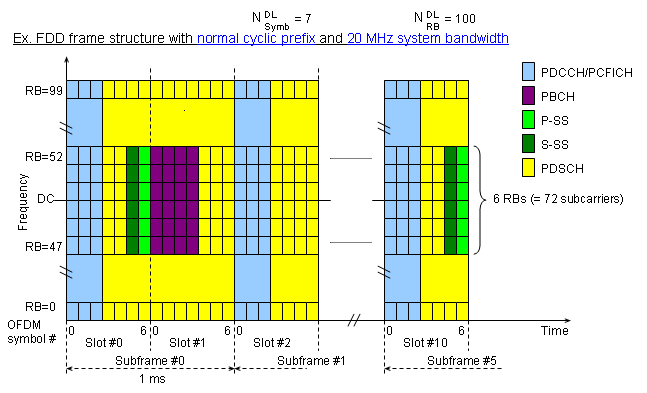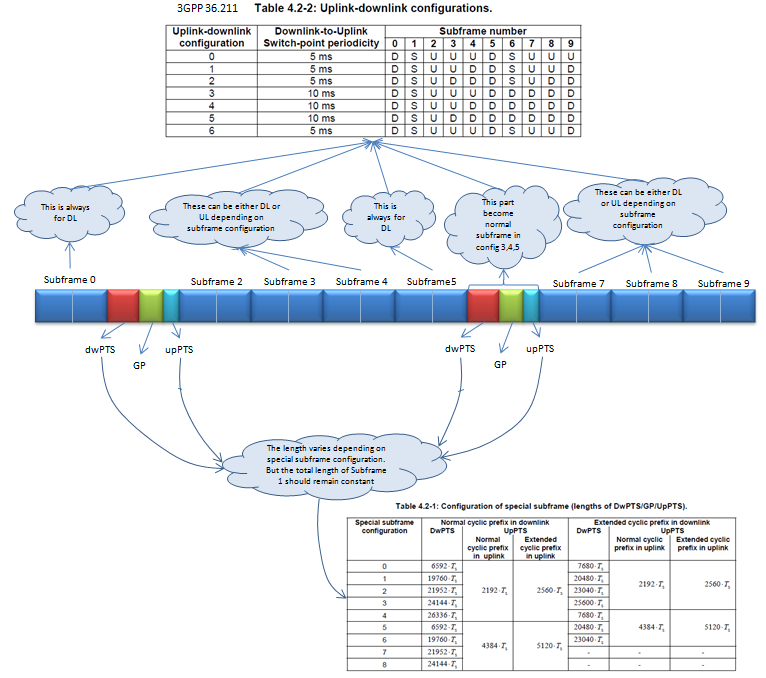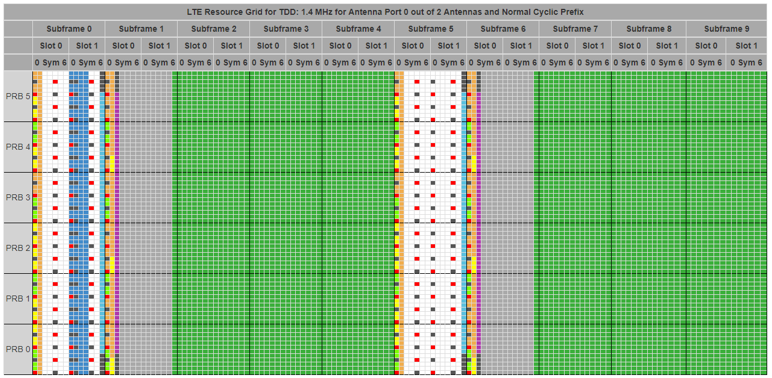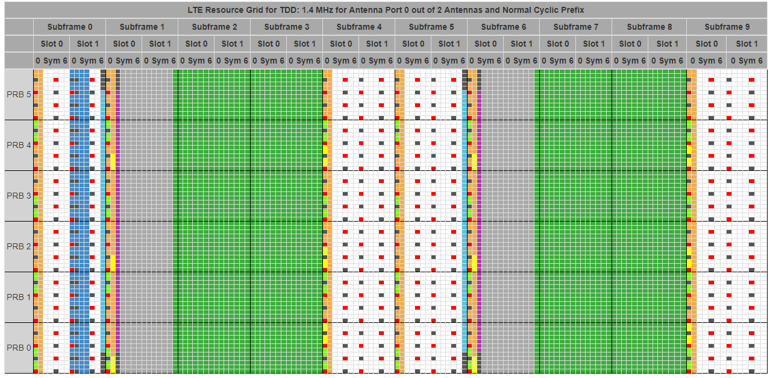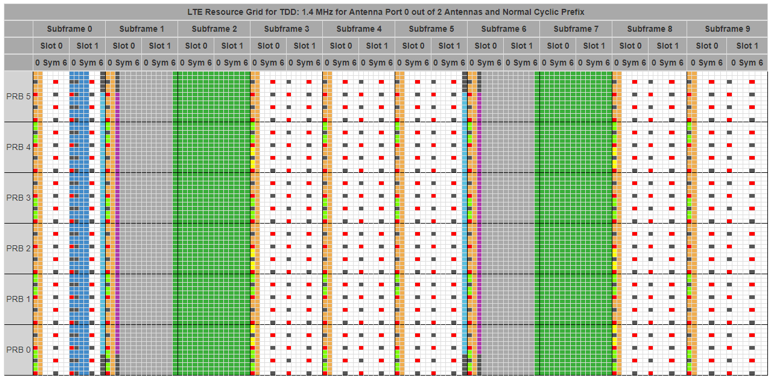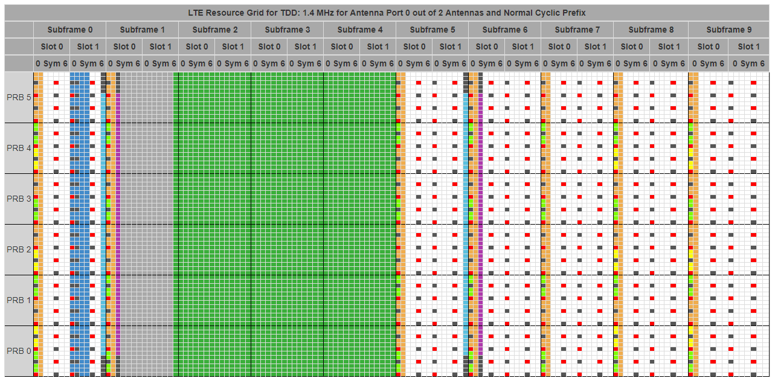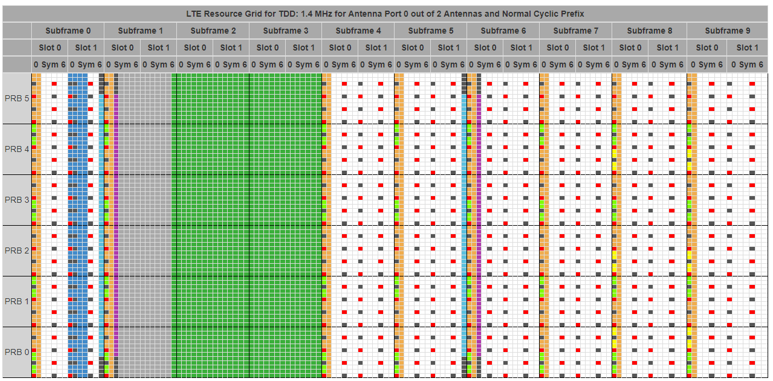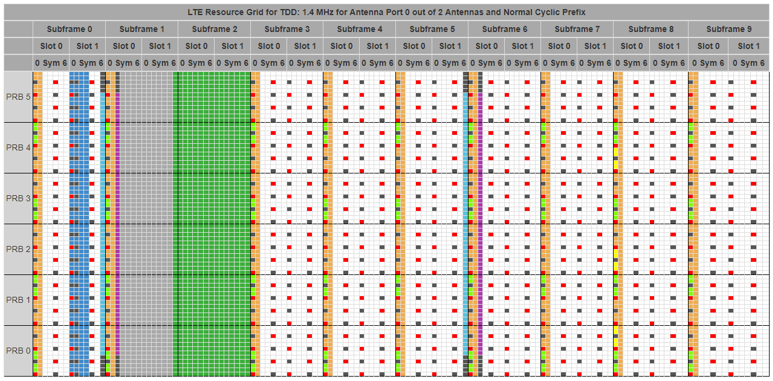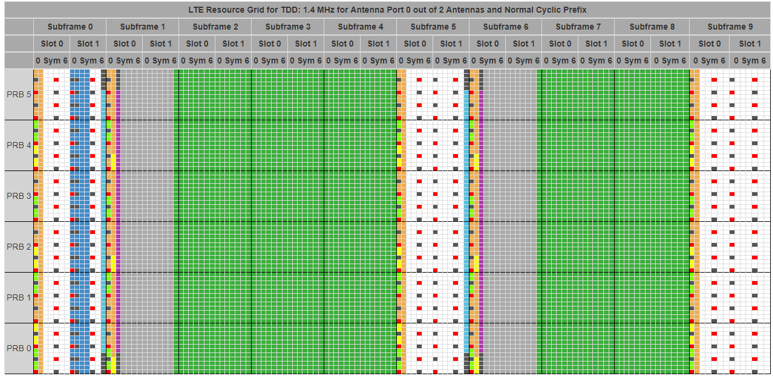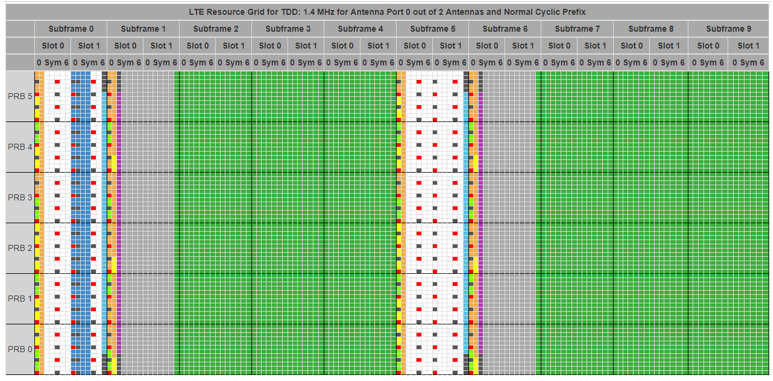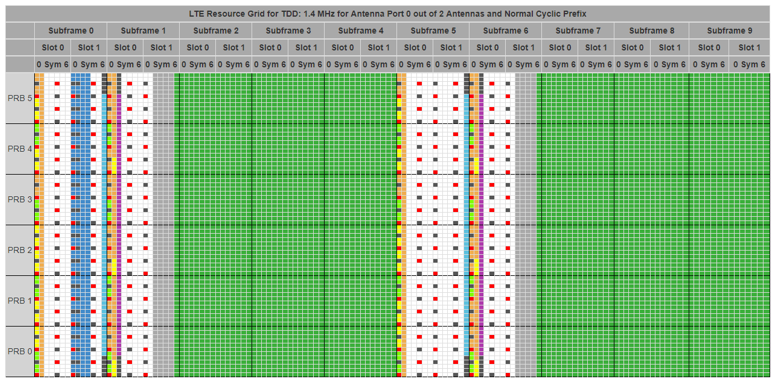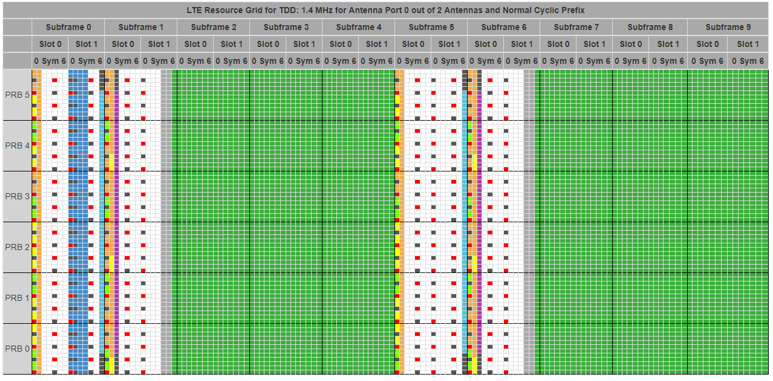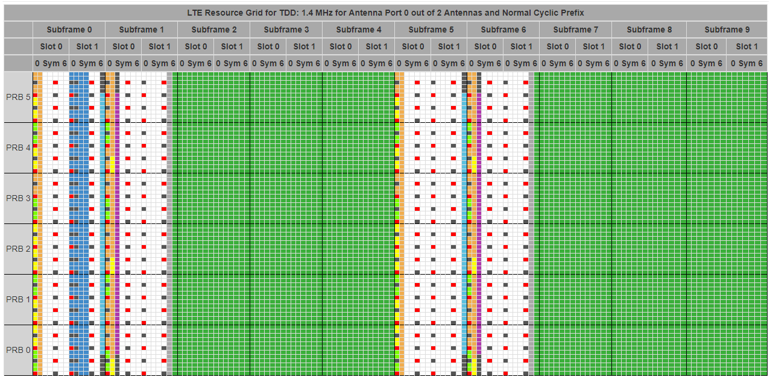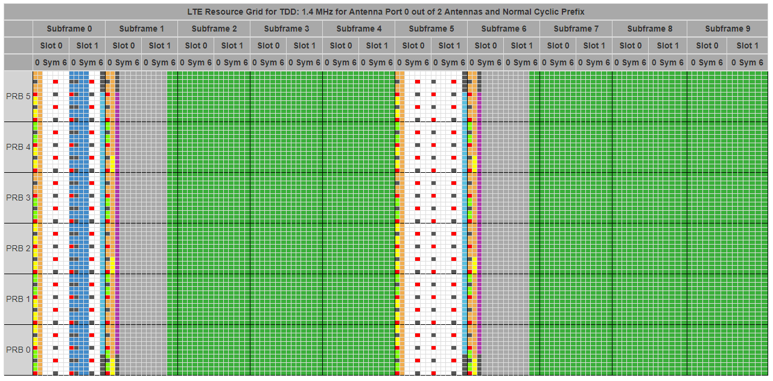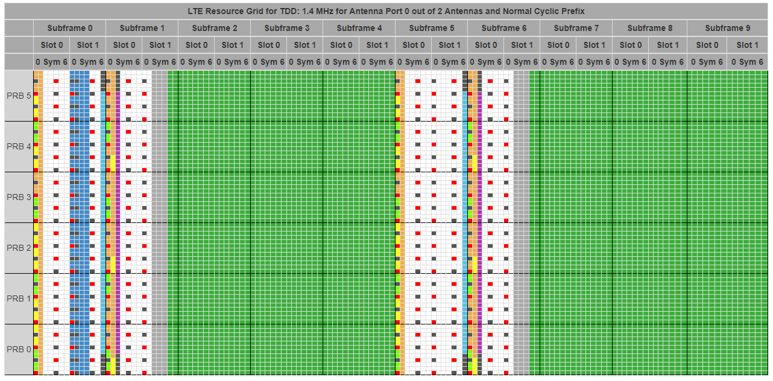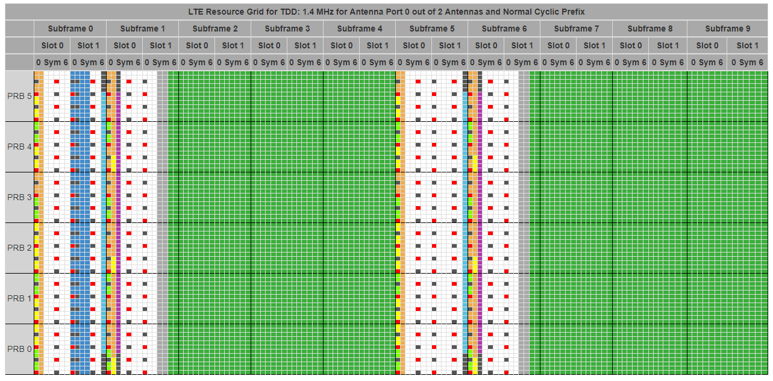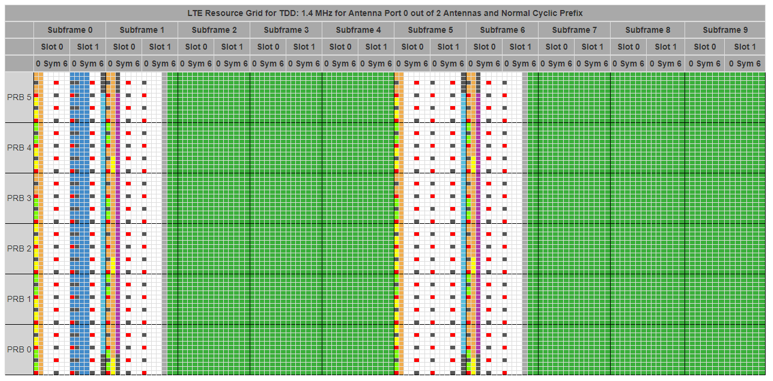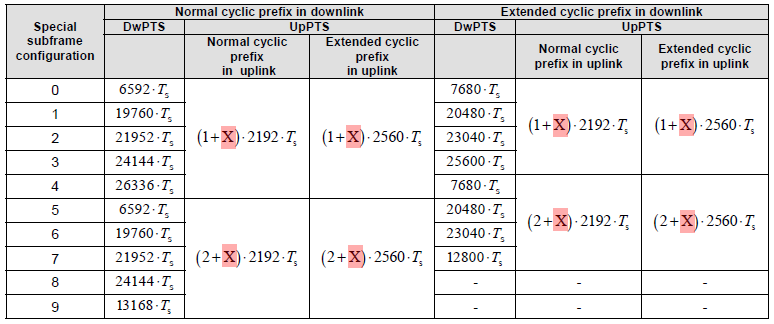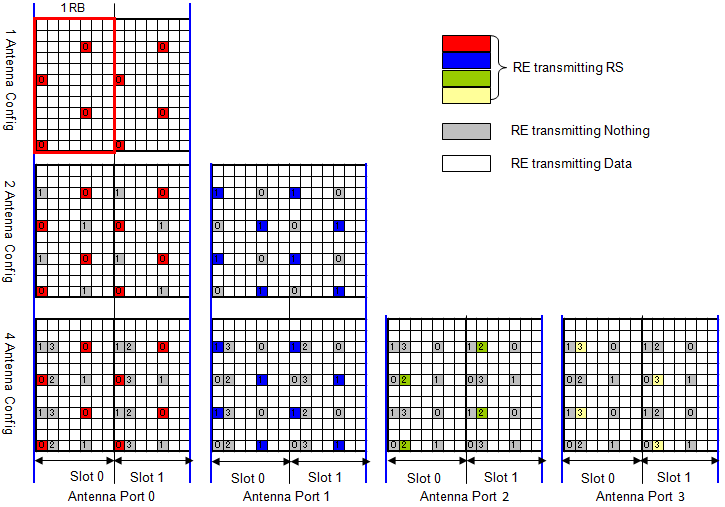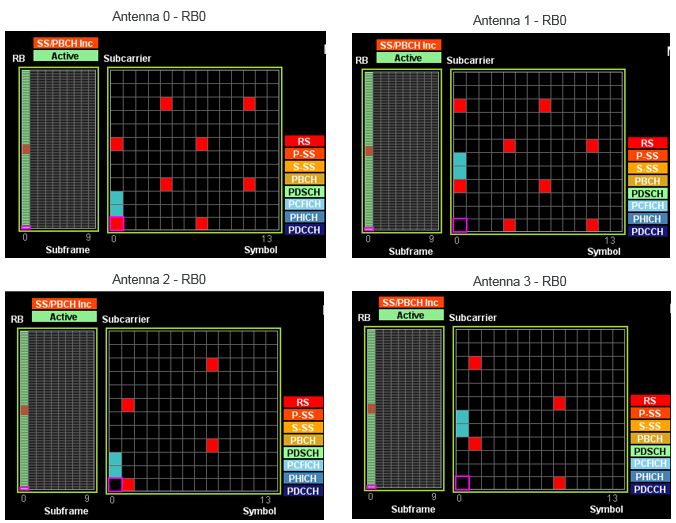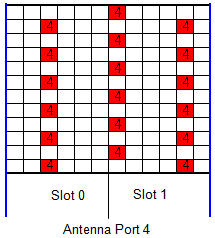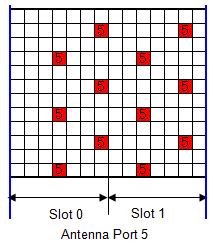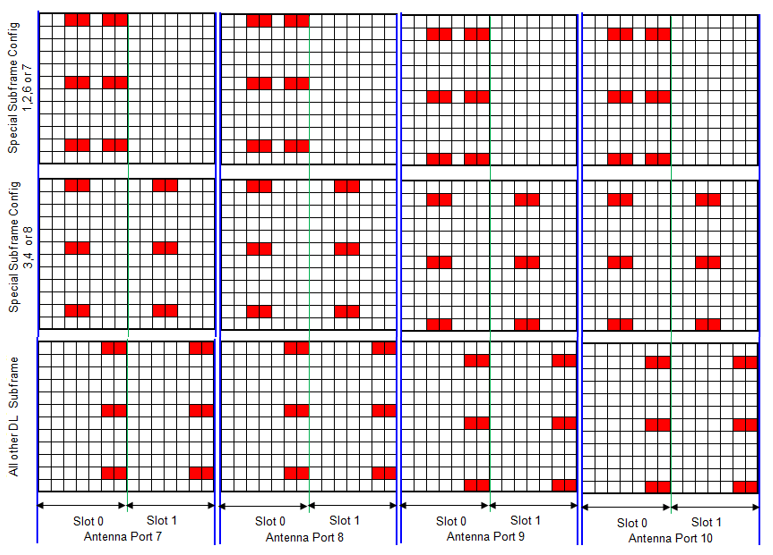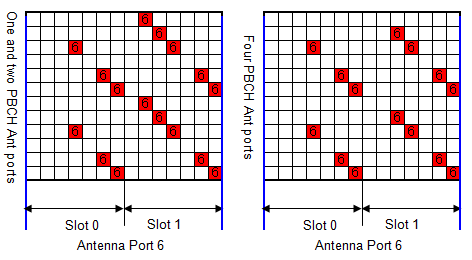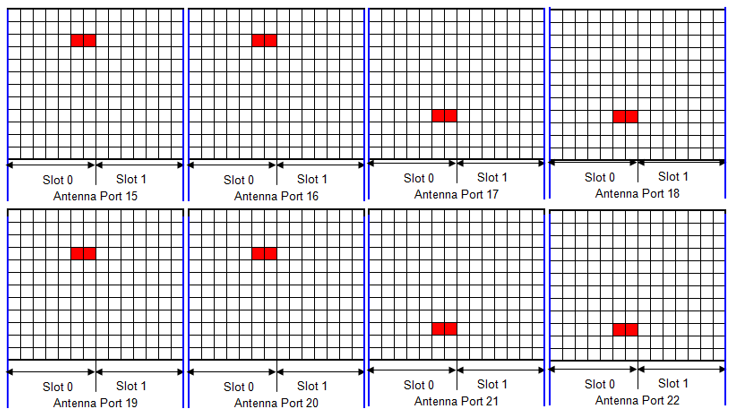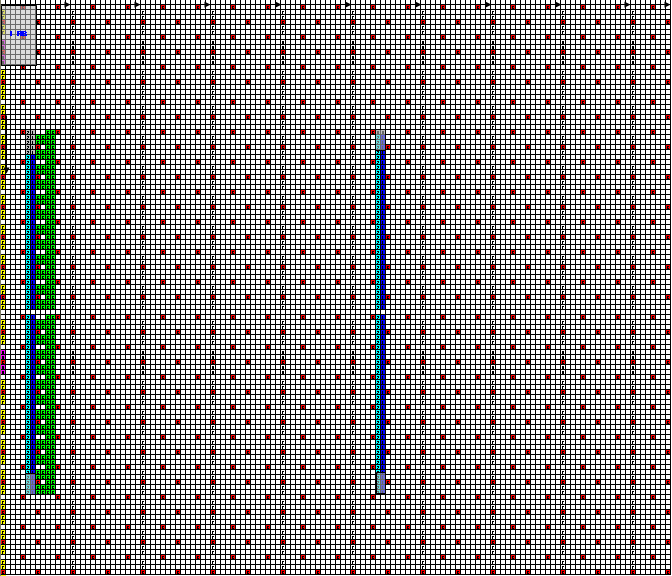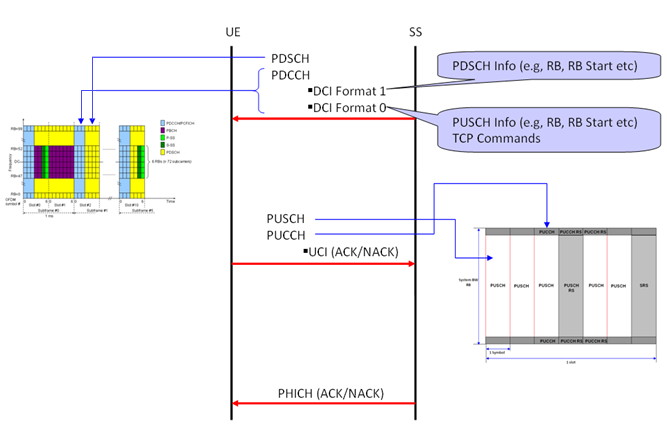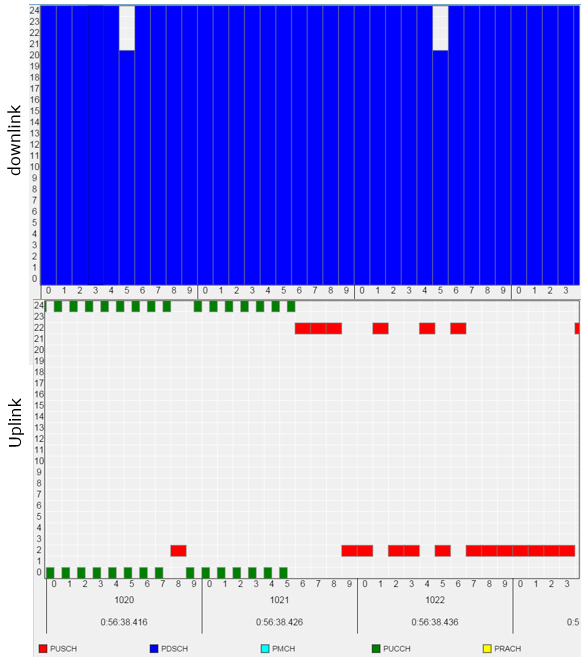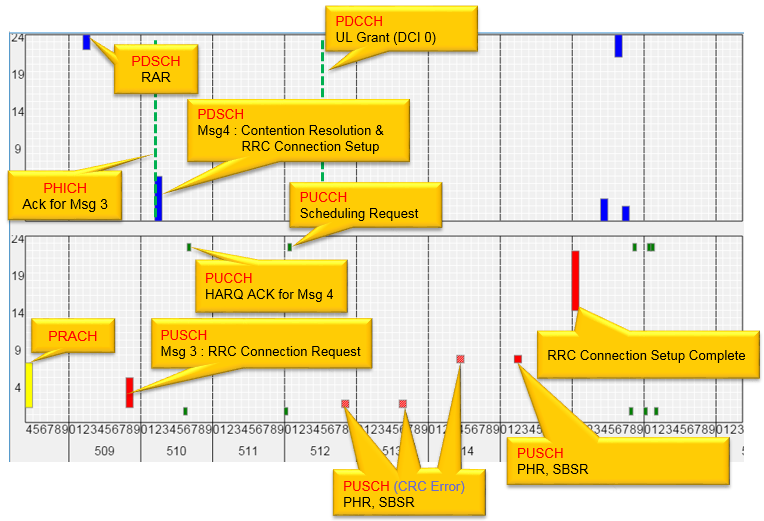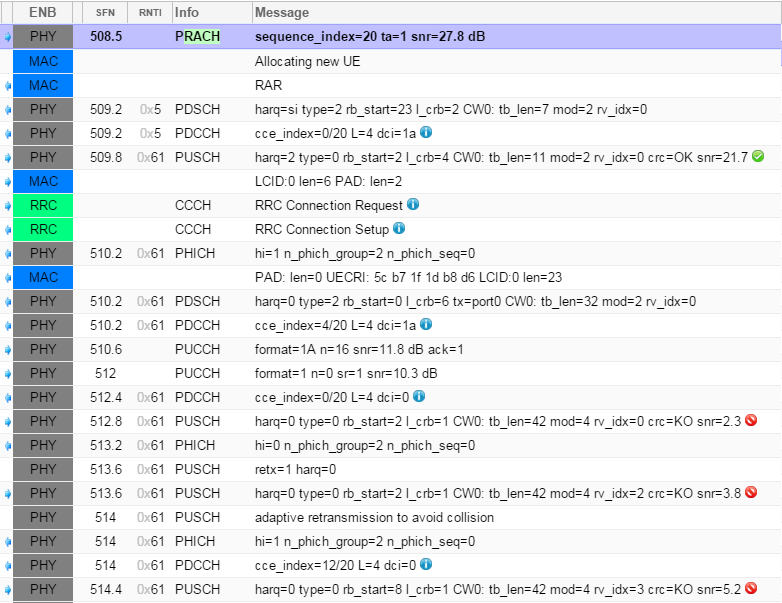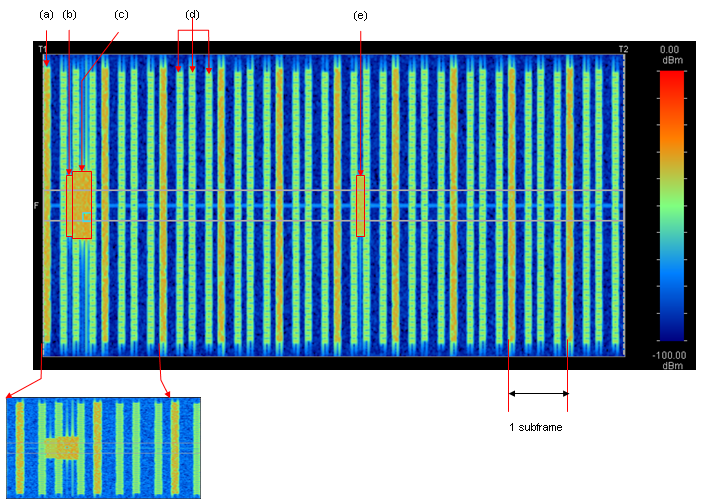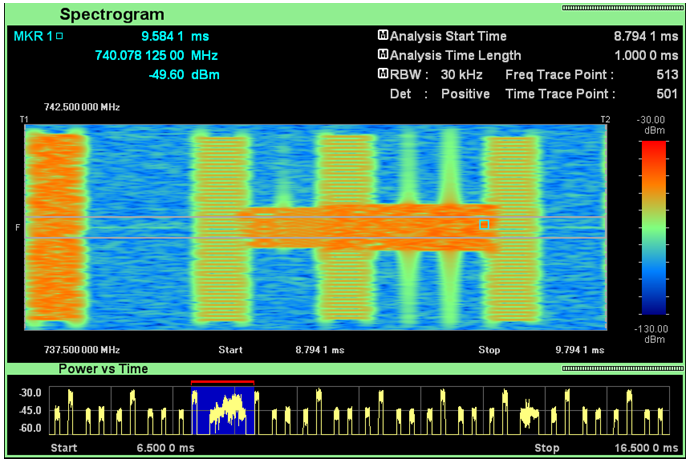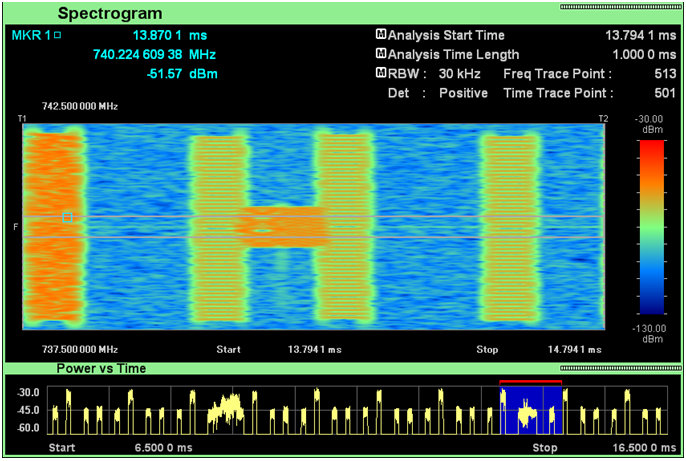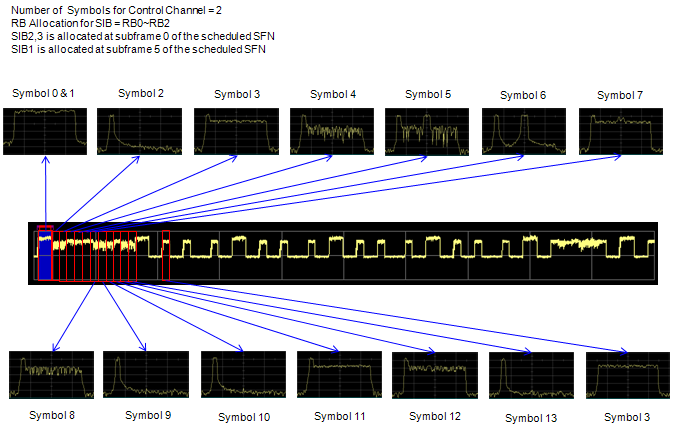|
4G/LTE - Frame Structure / Downlink |
|||||||||||||||||||||||||
|
LTE DL Frame Structure in a Nutshell
LTE DL Frame Structure in Detail
One good way to study this kind of thing and get some practical understanding would be to start from the view from the highest level and get deeper into it step by step.
Overview - FDD : Frame Structure Type 1
The highest level view from 36.211 for FDD LTE is as follows. It only shows the structure of one frame in time domain. It does not show any structure in frequency domain. Some of high level description you can get from this figure would be i) Time duration for one frame (One radio frame, One system frame) is 10 ms. This means that we have 100 radio frame per second. ii) the number of samples in one frame (10 ms) is 307200 (307.200 K) samples. This means that the number of samples per second is 307200 x 100 = 30.72 M samples. iii) Number of subframe in one frame is 10. iv) Number of slots in one subframe is 2. This means that we have 20 slots within one frame.
< 36.211 Figure 4.1-1 : Frame Structure type 1 >
So one slot is the smallest structure in time domain ? No, if you magnify this frame structure one step further, you would get the following figure. Now you see that one slot is made up of 7 small blocks called 'symbol'. (One symbol is a certain time span of signal that carry one spot in the I/Q constellation.). And you see even smaller structures within a symbol. At the beginning of symbol you see a very small span called 'Cyclic Prefix' and the remaining part is the real symbol data. There are two different type of Cyclic Prefix. One is normal Cyclic Prefix and the other is 'Extended Cyclic Prefix' which is longer than the Normal Cyclic Prefix. (Since the length of one slot is fixed and cannot be changed, if we use 'Extended Cyclic Prefix', the number of symbols that can be accomodated within a slot should be decreased. So we can have only 6 symbols if we use 'Extended Cyclic Prefix').
If you magnify a subframe to show the exact timing and samples, it can be illustrated as below. The length shown in this illustration does not vary with the Sampling Rate, but the number of samples in each symbol and CP varies with the sampling rate. The number of samples shown in this illustration is based on the case of 30.72 Mhz sampling rate.
A couple of things to be noticed about the subframe structure illustrated above is
Following shows the overal subframe structure from "LTE Resource Grid" (I realized that this site is not available any more. Fortunately, recently another expert put great effort to create another resource grid application and allowed me to share with everybody. Here goes Sandesh Dhagle's Resource Grid)
Following is an example of Downlink Frame Structure and RE (Resource Element) mapping for 4 Antenna case. Actually this is an ideal case of showing all 4 Antenna's signal super-imposed (overlapped). In reality, the signal from each antenna has a little different symbol data and reference signal position. The constellation shown on top and at the bottom of the RE mapping is the measurement result from LTE signal Analyzer measuring the LTE signal coming out of the LTE network simulator. This was captured at Antenna port 0 while LTE network is transmitting MIB/SIBs and UE is not connected. If you do the similar thing with different channel power (e.g, PCFICH power, PDCCH Power, CRS Power etc) you may see a little bit different constellation.
< FDD LTE Frame Structure with Constellation >
Now let's magnify the structure even further, but this time expand in frequency domain, not in time domain. You will get the following full detail diagram.
< FDD LTE Frame Structure with Focus On Physical Channels > The first thing you have to be very familiar with as an engineer working on LTE is the following channel map shown above.
We can represent an LTE signal in a two dimensional map as shown above. The horizontal axis is time domain and the vertical axis is frequency domain. The minimum unit on vertical axis is a sub carrier and the minimum unit on horizontal axis is symbol. For both time domain and frequency domain, there are multiple hiarachies of the units, meaning a multiple combination of a smaller unit become a larger units.
Let's look at the frequency domain structure first. LTE (any OFDM/OFDMA) band is made up of multiple small spaced channels and we call each of these small channels as "Sub Carrier". Space between the chhanel and the next channel is always same regardless of the system bandwidth of the LTE band. So if the system bandwidth of LTE channel changes, number of the channels (sub carriers) changes but the space between channels does not change.
Q> What is the space between a subcarrier and the next sub carrier ? A> 15 Khz Q> What is the number of channels(sub carriers) for 20 Mhz LTE band ? A> 1200 sub carriers. Q> What is the number of channels(sub carriers) for 10 Mhz LTE band ? A> 600 sub carriers. Q> What is the number of channels(sub carriers) for 5 Mhz LTE band ? A> 300 sub carriers.
Got any feelings about sub carriers and it's relation to system bandwidth ?
Now let's look at the basic units of horizontal axis which is time domain. The minimum unit of the time domain is a Symbol, which amounts to 66.7 us. Regardless of bandwidth, the symbol length does not changes.In case of time domain, we have a couple of other structures as well. The largest unit in time domain is a frame, each of which is 10 ms in length. Each of the frame consists of 10 sub frames, each of which is 1 ms in length. Each of sub frame consists of 2 slots, each of which is 0.5 ms in length.Each of slots consists of 7 symbols, each of which is 66.7 us.
With this in mind, let's think about the scale in reverse direction.
Q> How many symbols are there in a slot ? A> 7 symbols. Q> How many symbols in a sub frame ? A> 14 symbols. Q> How many slots are there in a frame ? A> 20 slots.
Now let's look at the units which is made up of both time domain (horizontal axis) and frequency domain (vertical axis). Let's call this type of unit a two-dimensional unit.
The minimum two dimensional unit is resource element which is made up of one symbol in time domain and one sub carrier in frequency domain. Another two dimensional unit is resource block(RB) which is made up of one slot in time domain and 12 sub-carrier in frequency domain. Resource Block(RB) is the most important units in LTE both for protocol side and RF measurement side. Now here goes questions.
Q> How many symbols in a resource block ? A> 7 symbols. Q> How many sub-carriers in a resource block ? A> 12 sub-carriers. Q> How many resource elements in a resource block ? A> 84 resource elements.
Now it's time to combine all the units we covered. The following questions are very important to read any of the LTE specification.
Q> How many resource blocks in a 20 Mhz band ? A> 100 resource blocks. Q> How many resource blocks in a 10 Mhz band ? A> 50 resource blocks. Q> How many resource blocks in a 5 Mhz band ? A> 25 resource blocks.
I have seen this type of mapping so many times from so many different sources, but do I really understand all the details of the map ? No not yet. It will take several years to understand every aspects of the map.
Probably what I do as the first step is to describe each part of the map in a verbal form
Overview-TDD : Frame Structure Type 2
Followings are examples for various TDD UL/DL configurations. I got all of the following examples using Sandesh Dhagle's Resource Grid.
< TDD UL/DLConfiguration 0, Special Subframe Config 0 >
< TDD UL/DLConfiguration 1, Special Subframe Config 0 >
< TDD UL/DLConfiguration 2, Special Subframe Config 0 >
< TDD UL/DLConfiguration 3, Special Subframe Config 0 >
< TDD UL/DLConfiguration 4, Special Subframe Config 0 >
< TDD UL/DLConfiguration 5, Special Subframe Config 0 >
< TDD UL/DLConfiguration 6, Special Subframe Config 0 >
Followings are the examples showing the radio resource grid with different Special Subframe Configuration. In these examples, just pay attention to how the symbol structure in subframe 0 and subframe 6 varies.
< TDD UL/DLConfiguration 0, Special Subframe Config 0 >
< TDD UL/DLConfiguration 0, Special Subframe Config 1 >
< TDD UL/DLConfiguration 0, Special Subframe Config 2 >
< TDD UL/DLConfiguration 0, Special Subframe Config 3 >
< TDD UL/DLConfiguration 0, Special Subframe Config 4 >
< TDD UL/DLConfiguration 0, Special Subframe Config 5 >
< TDD UL/DLConfiguration 0, Special Subframe Config 6 >
< TDD UL/DLConfiguration 0, Special Subframe Config 7 >
< TDD UL/DLConfiguration 0, Special Subframe Config 8 >
Overview-LAA : Frame Structure Type 3
From 3GPP Rel 13, a new frame structure (Frame Structure Type 3) and major application of this type is LAA. I don't find much details on this as of 36.211 V13.1.0. Following description is all for now. I think the green part is same as the existing frame type (Type 1 / Type 2) and the blue part is unique to Type 3.
Frame structure type 3 is applicable to LAA secondary cell operation with normal cyclic prefix only. Each radio frame is Tf = 307200⋅Ts =10ms long and consists of 20 slots of lengthTslot = 15360⋅Ts = 0.5 ms , numbered from 0 to 19. A subframe is defined as two consecutive slots where subframe i consists of slots 2i and 2i +1 .
The 10 subframes within a radio frame are available for downlink transmissions. Downlink transmissions occupy one or more consecutive subframes, starting anywhere within a subframe and ending with the last subframe either fully occupied or following one of the DwPTS durations in Table 4.2-1.
Another differences in Rel 13 is in following table. As you see here, in Rel 13 the length of UpPTS became parameterized (become a variable). If you set X = 0, the table is indentical to Frame type 2 case. I think X would get different values in Frame Type 3, but I haven't found any details about the value range of this parameter X yet (I will update as I find more information).
< 36.211 Table 4.2-1: Configuration of special subframe (lengths of DwPTS/GP/UpPTS) >
Physical Channels and Signals in Radio Frame
Now I will talk about the details of various type of physical channels that will be embedded into the frame structure shown above. The description on this page is just an overview of each physical channels. It is too much to put all the details of each physical channels in single page. I recommed you to use this as a summary (cheat sheet) for each channels and refer to other pages linked under each descriptions if you want to get further details.
PBCH(Physical Broadcast Channel)
The first L(1 or 2 or 3) Symbols
This is one of the most confusing area of the map because multiple channels are located in this area. On the first symbol is PCFICH but PCFICH takes only part of the resource blocks on the first symbol not all. PHICH is carried by this area as well. And the remaining space not occupied by PCFICH and PHICH is allocated for PDCCH.
PCFICH(Physical Control Format Indicator Channel)
PDCCH(Physical Downlink Control Channel)
The physical downlink control channel carries scheduling assignments and other control information. A physical controlchannel is transmitted on an aggregation of one or several consecutive control channel elements (CCEs), where a control channel element corresponds to 9 resource element groups. The number of resource-element groups notassigned to PCFICH or PHICH is REG N . The CCEs available in the system are numbered from 0 and N_CCE-1 , where N_CCE = floor(N_REG/9) . The PDCCH supports multiple formats as listed in Table 6.8.1-1. A PDCCH consisting of nconsecutive CCEs may only start on a CCE fulfilling imod n = 0 , where i is the CCE number.
PDSCH(Physical Downlink Shared Channel)
RS (Reference Signal ) - Cell Specific
Most of the channels (e.g, PDSCH, PDCCH, PBCH etc) is for carrying a special information (a sequence of bits) and they have some higher layer channel connected to them, but Reference Signal is a special signal that exists only at PHY layer. This is not for delivering any specific information. The purpose of this Reference Signal is to deliver the reference point for the downlink power.
When UE try to figure out DL power (i.e, the power of the signal from a eNode B), it measure the power of this reference signal and take it as downlink cell power.
These reference signal are carried by multiples of specific Resource Elements in each slots and the location of the resource elements are specifically determined by antenna configuration.
In the figures below, Red/Blue/Green/Yellow is the part where the reference signal are carried and the resource elements marked in gray are the ones reserved for reference signal, but are not carrying Reference Signal for that specific antenna. (Follwing illustration is based on 36.211 Figure 6.10.1.2-1. Mapping of downlink reference signals (normal cyclic prefix))
< LTE Cell Specific Reference Signal (CRS) >
Following is an example of physical channel configuration and RE (Resource Element) mapping for 4 Antenna case. The measurement result is from LTE signal Analyzer measuring the LTE signal coming out of the LTE network simulator. It shows only one RB (RB0) of 20 Mhz System Bandwidth (i.e, 100 RBs in total) and was captured at Antenna port 0, 1, 2, 3 respectively while LTE network is transmitting MIB/SIBs and UE is not connected. You would notice that location of Reference Signal is different for each antenna. Due to this reference signal location difference, the REG grouping may vary slightly resuting in a little bit different location of PCFICH.
< LTE Cell Specific Reference Signal for Each Antenna >
There are two different types of reference signal : Cell Specific Reference Signa and UE specific Reference Signal
Is the Resource element for the cell specific reference signal fixed ?
No, the location changes according to Physical Cell ID as described below.
What kind of value is carried by the downlink reference signal ?
The value is a pseudo random sequence generated by the algorithm defined in 36.211 6.10.1.1 Sequence Generation and described in Physical Layer : Cell Specific Reference Signal page.(Note : The uplink reference signal - DMRS (i.e, PUSCH DMRS and PUCCH DMRS) - is Zadoff Chu sequence)
One of the determining value of this sequence is Physical Cell ID, meaning that the physical cell ID influences the value of the reference signal as well.
Is CRS transmitted in any subframe type (type 1, 2, 3) ?
At the initial phase of LTE develoyment, you haven't doubt on that every LTE subframe would carries CRS(Cell Sepecific Reference Signal) in it. But as we see more diverse types of subframe structure (FDD-frame structure Type1, TDD -frame structure Type 2, LAA - frame structure type 3), I see my confidence gets weaker. The question is 'Does every frame type(type 1, 2, 3) transmit CRS ?
The short anwer is 'YES'. More detailed answer is following as stated in 36.211 - 6.10.1 Cell-specific Reference Signal (CRS).
RS (Reference Signal ) - MBSFN
Following is based on 36.211 Figure 6.10.2.2-1: Mapping of MBSFN reference signals (extended cyclic prefix, Δf = 15 kHz )
RS (Reference Signal ) - UE Specific
Following is based on 36.211 Figure 6.10.3.2-1: Mapping of UE-specific reference signals, antenna port 5 (normal cyclic prefix)
< Reference Signal - UE Specific - Antenna Port 5 >
< Reference Signal - UE Specific - Antenna Port 5 >
RS (Reference Signal ) - Positioning
Following is based on 36.211 Figure 6.10.4.2-1: Mapping of positioning reference signals (normal cyclic prefix)
< Reference Signal - Positioning - Antenna Port 6 >
Following is based on 36.211 Figure 6.10.5.2-1: Mapping of CSI reference signals (CSI configuration 0, normal cyclic prefix)
< Reference Signal - CSI - Antenna Port 15,16,17,18,19,20,21,22 >
Following is a snapshot showing the whole channels described above. Of course this is not to give you the detailed information. It is to give you a overall picture of a whole frame. Would you be able to identify the locations of each channels described above ? Just try it, it will be a good practice.
Each components in this grid has it's own role and used in various different context. If you are interested in how each of these channels are used in real communication process, refer to following sections in Quick Reference page.
Physical Channels in Communication
Following diagram shows overall sequence of Uplink/Downlink data transmission. You would be able to associate the data transmission sequence diagram and the specific location of each channels in DL/UL frame structure.
< Physical Channels in Communication >
Following is an example of channel map that is happening during real communication between UE and Amarisoft LTE Network Simulator. It has an excellent log analysis tool that shows physicall channel mapping for every subframe as shown below. If you roll over mouse pointer onto each channel, it will give you the detailed physical parameter. It would be very helpful for troubleshooting and for study. This example is a snapshot while I was watching YouTube over the phone.
Now let's look at another example, which might look more complicated and confusing but hopefully look more interesting :). This shows an example of what's happening during the initial process (RACH process) after you turn on your mobile phone. Again, the log and background RB map is from Amarisoft LTE Network simulator. All the labels were put manually (If you roll over the mouse pointer onto each channel it shows some detailed information, but it would not show information on the exact contents. This is understandable.. because Physical channel by itself does not have any detailed knowledge on the contents).
< LTE RB Map - Example 02 - 1 >
How can I figure out all the details printed on each labels shown above ? It came from the text based log as shown below. It took me almost an hour to pul all the lables shown above based on the log below. However, this can be a good practice if you are at learning phase of LTE protocol.. or you HAVE TO go through this tedious process when you are in troubleshooting situation.
< LTE RB Map - Example 02 - 2 >
I would not put much of the comments for the following captures. These captures are for your practice to associate what you read in previous sections to the real life signal pattern.
< Spectrogram - LTE FDD DL - Radio Frame >
< Spectrogram - LTE FDD DL - PBCH >
< Spectrogram - LTE FDD DL - PSS/SSS>
< Spectrogram - LTE FDD DL - Each Symbol >
|
|||||||||||||||||||||||||

